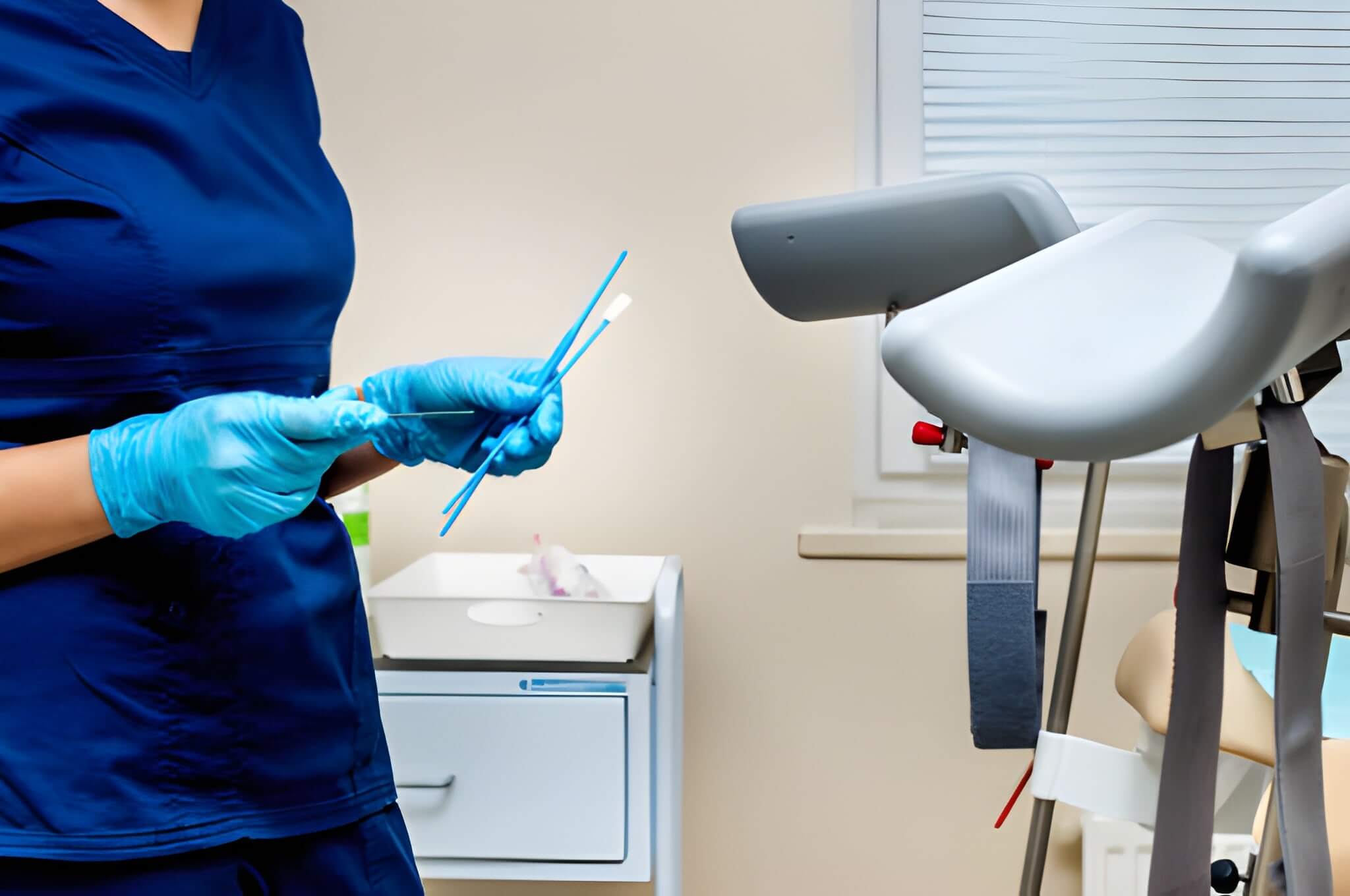Many patients ask me during checkups, “Will a Pap smear test for STDs?” It’s a common question — and an important one. The short answer is no, a Pap smear does not directly test for sexually transmitted diseases (STDs). But it can sometimes reveal signs that suggest an infection, prompting further testing.
As a family nurse practitioner in Hartford specializing in women’s pelvic health, I perform Pap tests daily. Understanding what a Pap smear checks for — and what it doesn’t — helps patients stay proactive about their sexual and reproductive health.
What a Pap Smear Actually Tests For
A Pap smear, also called a Pap test, screens for precancerous or cancerous changes in cervical cells. These changes are most often caused by the human papillomavirus (HPV) — one of the most common sexually transmitted infections.
So, while a Pap test can detect HPV-related cell changes, it does not directly test for other STDs like chlamydia, gonorrhea, or herpes.
During a Pap test, a small brush or spatula collects cells from the cervix. These cells are then analyzed under a microscope for abnormal changes.
In some cases, an HPV test is done at the same time — especially for women over 30. This combined approach gives a broader view of cervical health.
Does a Pap Smear Test for STDs?
No, a Pap smear doesn’t test for most sexually transmitted infections. However, it can indirectly suggest an infection if inflammation or unusual cell patterns are found.
For example, if your Pap smear shows signs of inflammation, your clinician may recommend additional STD testing, such as for chlamydia, gonorrhea, or trichomoniasis.
To be clear:
-
Pap smear = cervical cell screening
-
STD tests = infection screening
These are two different processes, but both are vital parts of preventive care.
Pap Smear and STD Testing: What’s the Difference?
Let’s break down the main difference.
A Pap smear looks for cell changes that could lead to cervical cancer.
STD testing, on the other hand, looks for bacteria, viruses, or parasites that cause infections.
For STD testing, your provider may use:
-
Urine samples (for chlamydia or gonorrhea)
-
Blood tests (for HIV, syphilis, or hepatitis)
-
Swabs (for herpes, HPV, or trichomoniasis)
Sometimes both tests are done during the same appointment — especially for sexually active individuals under 30, or those with new partners.
If you’re unsure whether you’ve had pap smear and STD testing done together, ask your provider to clarify. It’s common for patients to assume both are performed automatically, but that’s not always the case.
Can a Pap Smear Test for Herpes?
This question comes up often: “Would a Pap smear show herpes?”
No, a Pap smear does not test for herpes. The herpes simplex virus (HSV) cannot be detected through cervical cell sampling. However, if you have visible sores or irritation, your clinician can perform a viral culture or PCR test to confirm herpes infection.
In some cases, a Pap test might reveal cellular changes consistent with an HSV infection, but this is not diagnostic. A specific test for herpes is needed for confirmation.
So, if you’re experiencing symptoms like burning, sores, or itching, tell your provider. A Pap alone won’t give you the full picture.
Do Pap Smears Detect Any STDs at All?
While Pap smears don’t directly test for most STDs, they can help flag possible infections that require follow-up. For example:
-
HPV is often detected through a Pap + HPV co-test.
-
Trichomonas (a parasitic infection) can sometimes appear in Pap results.
-
Inflammation may signal the presence of another infection.
But conditions like chlamydia, gonorrhea, HIV, syphilis, and herpes need dedicated tests.
If you’re due for your Pap smear, it’s smart to ask your provider to include comprehensive STD testing at the same visit.
Can a Pap Test Detect Herpes or Other Viral STDs?
A Pap test can detect HPV-related cell changes, but not herpes or HIV. Each virus requires different testing methods.
For herpes, a swab test or blood test is used.
>For HIV, a blood or saliva test detects antibodies.
>For HPV, a Pap or HPV DNA test checks cervical cells.
If you have multiple sexual partners or are concerned about exposure, it’s wise to schedule routine STD testing alongside Pap screening.
Will a Pap Smear Detect STDs in Men?
Pap smears are only performed on individuals with a cervix — typically women and some transgender or nonbinary patients. Men do not receive Pap smears.
However, men can and should be tested for STDs through urine, swab, or blood testing as needed.
Why Routine Testing Matters
Whether you’re in a long-term relationship or not, routine screening protects your health and your partner’s. Many STDs cause no symptoms but can still lead to complications like infertility or chronic pain if untreated.
Scheduling a Pap smear every 3 years (or every 5 years with HPV testing) helps detect precancerous changes early. Adding STD testing ensures you catch infections before they cause harm.
I tell my Hartford patients this often: “Your Pap test and STD screening work best together — like two sides of the same shield for your reproductive health.”
Experience from Practice
In my clinical experience, many women believe that a Pap smear automatically includes STD testing. It’s a common misconception, especially among young adults and new patients.
I often explain during visits: “A Pap tells us how your cervical cells look. STD tests tell us what might be causing infection.” Once patients understand the difference, they feel more confident requesting both.
In one recent case, a patient came in for her routine Pap, assuming all infections would be covered. Her results were normal, but additional STD testing showed chlamydia — which we treated early. That’s why combining both tests is essential.
When to Ask for STD Testing Alongside Your Pap
Ask for STD testing during your Pap if:
-
You have a new sexual partner.
-
You’ve had unprotected sex.
-
You notice unusual discharge or pelvic pain.
-
You’re under 25 (CDC recommends yearly chlamydia and gonorrhea testing).
-
You simply want peace of mind.
STD testing is confidential, quick, and often covered by insurance.
FAQs
Q1: Does a Pap smear test for STDs?
No. A Pap smear checks for abnormal cervical cells, not for infections like chlamydia or gonorrhea.
Q2: Can a Pap smear test detect herpes?
No. Herpes requires a separate test such as a swab or blood test.
Q3: Do Pap smears detect any STDs at all?
Sometimes they show signs of HPV or inflammation, but further tests are needed to confirm.
Q4: What’s the difference between a Pap test and STD test?
Pap tests look for cervical cell changes; STD tests look for infections.
Q5: How often should I get both tests?
Most women need a Pap every 3 years and STD testing annually, depending on risk.
Final Thoughts
So, will a Pap smear test for STDs? Not directly — but it plays a key role in overall sexual health.
Think of your Pap test as a screen for cellular health, and STD testing as a screen for infection. Together, they provide a full picture of reproductive wellness.
If you’re in Hartford or nearby, schedule a combined Pap and STD test with your healthcare provider. Taking that extra step protects your long-term health and gives you peace of mind.
Disclaimer: This is informational content, not a substitute for professional medical advice.

Meghan Killilea Galli, APRN, FNP-BC, is a Connecticut-based board-certified Family Nurse Practitioner with over 5 years of experience in urology, women’s pelvic health, and primary care. She practices with Hartford HealthCare and Griffin Faculty Practice Plan and founded Health Gardeners to share reliable, evidence-based health information.
Read More

